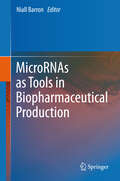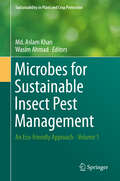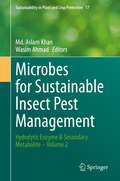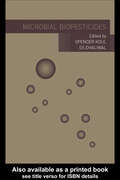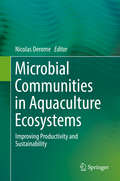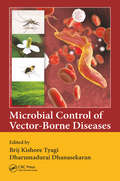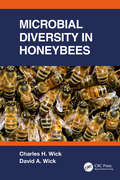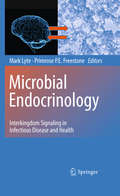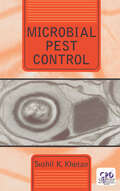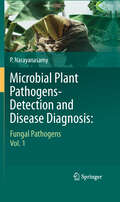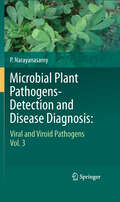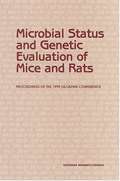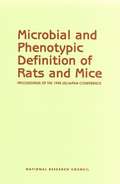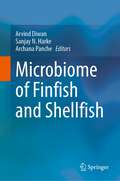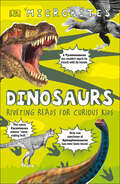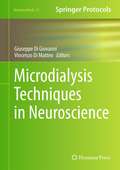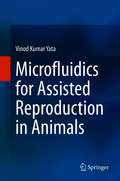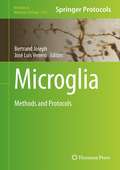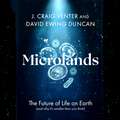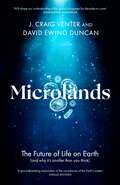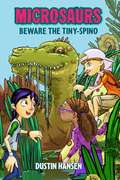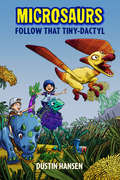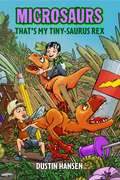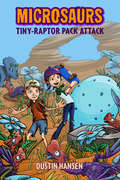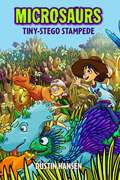- Table View
- List View
MicroRNAs as Tools in Biopharmaceutical Production
by Niall BarronFocused manuscript on the potential use/role of miRNAs in bioprocessing, specifically the production of complex proteins in mammalian cells. With that in mind I propose a draft list of topics/chapters along the following lines: Intro on CHO/bioprocessing/engineering challenges to set scene, Genomic organization, biogenesis and mode of action, Identifying miRNA targets: Computational prediction, transcriptomics, proteomices, UTR analysis, etc., miRNA expression in Chinese Hamster Ovary cells, miRNAs as engineering targets: pathway manipulation to impact bioprocess phenotypes, miRNAs as biomarkers, Detection methods: Northern, PCR, hybridization arrays, Next Gen Seq, Manipulation of expression in cultured cells: Transient/stable disregulation, Knockout.
Microbes for Sustainable Insect Pest Management: An Eco-friendly Approach - Volume 1 (Sustainability in Plant and Crop Protection)
by Md. Aslam Khan Wasim AhmadThis Volume comprises 14 chapters in an attempt to provide the reader with available information on safe and effective use of entomopathogens. Chapters in this book dealing with soil-borne entomopathogens and their phylogeny also provide a review on most updated information of their isolation and molecular identification. Employing fungal pathogens in biological control programmes plays a key role, and conidial thermotolerance and oxidative stress are examined in separate chapters. Entomopathogenic bacteria are able to kill their hosts quickly. An important contribution concerns informations provided upon bacterial cytotoxic factors on insect haemocytes. Nematodes are biological control agents safe to the environment. The information with respect to their direct and indirect effects on non-target organisms is provided. Viruses as highly specific, virulent candidates for use as biological insecticides are safe to non-target species. A separate chapter on the role of granuloviruses in IPM contributes a wealth of information. Biopesticides in combination with synthetic insecticides are reported as effective, economic, and eco-friendly. Understanding their interactions will certainly promote their uses. Finally, emphasis has been given on reviewing synergistic and antagonistic interactions of microbial and chemical pesticides, in other chapters.
Microbes for Sustainable lnsect Pest Management: Hydrolytic Enzyme & Secondary Metabolite – Volume 2 (Sustainability in Plant and Crop Protection #17)
by Md. Aslam Khan Wasim AhmadThe search for new strategies of pest control with safer molecules is currently of great importance and interest. Microbe-mediated biological crop protection is an attractive and promising technology with no concern for a negative impact on the environment and biodiversity. Microbial hydrolytic enzymes such as proteases, chitinases, lipases, etc. are attractive for this purpose. They present toxic properties and act synergistically to control pest attacks. Also, some metabolites, that microorganisms produce for their survival or defense, can be explored and exploited for plant protection. The focus of this Volume is on the potential of microbial hydrolytic enzymes and their metabolites in agroecosystem functioning. Subsequent chapters review topics such as microbial hydrolytic enzymes as powerful management tools, chitinases in IPM of agro-horticultural crops, metabolites as pesticides and the importance of the metabolites of entomopathogenic fungi, metabolites and virulence factors. Other topicas include: microbial-based nanoparticles, recombinant DNA technologies to improve the efficacy of microbial insecticides, the effects of entomopathogens on insect predators and parasitoids, and the management of major vegetable insect pests. This Volume provides detailed accounts on the safe use of microbial products for sustainable management of insect pests. Its aim is to build solid foundations for the students, teachers, and researchers interested in eco-friendly management of important insect crop pests.
Microbial Biopesticides
by Opender Koul G. S. DhaliwalBiotechnological research has provided key developments in pest control agents, focusing on pathogens of insect pests as formulated biological pesticides. Emphasis has been placed on bacteria and viruses as they are well understood and easily manipulated. Microbial Biopesticides provides a comprehensive overview of the advances made in the use of bacteria, fungi, and viruses, while focusing on behavioral, chemical, and molecular aspects. The authors discuss the potential of nematode-based biochemical agents and bioherbicides and explore the role of microbial biopesticides in integrated pest management and their prospects for commercial exploitation.
Microbial Communities in Aquaculture Ecosystems: Improving Productivity and Sustainability
by Nicolas DeromeThis book sheds light on the major functions of microbial communities in aquaculture ecosystems, showing that by recycling nutrients, degrading organic matter and preventing disease outbreaks, a variety of microbes are truly beneficial to a wide range of aquaculture industries. It discusses how deteriorating environmental quality enables some microbial strains to trigger disease, describes the development of highly sustainable tools to improve water quality, and identifies crucial factors that endanger microbial homeostasis in aquaculture ecosystems.The book also covers post-antibiotic approaches for preventing and treating opportunistic microbial infections based on harnessing environmental and fish-associated microbial communities. Furthermore, it explores how manipulating and engineering these complex microbial communities using bio-agents such as probiotics, phages, natural nutritional additives, or with fine-tuned biofilters will open the door for new ways to develop a more sustainable and cost-effective aquaculture industry. Including an accessible presentation of modern high-throughput sequencing technology to identify host-microbial interactions in aquaculture ecosystems, this book is a valuable resource for scientists, aquaculture and fishery experts, sustainability enthusiasts and scholars in the areas of biology and marine agriculture.
Microbial Control of Vector-Borne Diseases
by Brij Kishore Tyagi Dharumadurai DhanasekaranVector-borne diseases have increasingly emerged as significant causes of human illnesses worldwide, largely due to environmental changes (deforestation), population movements (migration and travelling), international trades, and buildup of drug resistance. These are presenting major challenge to the efficacy and use of conventional tools for controlling vector-borne diseases. Therefore, use of microbial approach for the control of vector-borne diseases is gaining importance. This book comprehensively reviews vector-borne diseases and their microbial control, emphasizing majorly on ecofriendly ways of microbial control.
Microbial Diversity in Honeybees
by Charles H. Wick David A. WickHoneybees are an important link in our food chain because they are major pollinators of food crops. In recent years, honeybee populations have declined precipitously perhaps due to changes in their microbiome. This book describes and identifies the bee microbiome using a proteomics technology. Chapters include the detection and identification of microbes found in honeybees collected around the United States. This book contains new data and illustrates the rich diversity of microbes as collected by honeybees. It is a must read for everyone concerned about the honeybee and working in the industry.
Microbial Endocrinology
by Mark Lyte Primrose P.E. FreestoneMicrobial endocrinology represents a newly emerging interdisciplinary field that is formed by the intersection of the fields of neurobiology and microbiology. This book will introduce a new perspective to the current understanding not only of the factors that mediate the ability of microbes to cause disease, but also to the mechanisms that maintain normal homeostasis. The discovery that microbes can directly respond to neuroendocrine hormones, as evidenced by increased growth and production of virulence-associated factors, provides for a new framework with which to investigate how microorganisms interface not only with vertebrates, but also with invertebrates and even plants. The reader will learn that the neuroendocrine hormones that one most commonly associates with mammals are actually found throughout the plant, insect and microbial communities to an extent that will undoubtedly surprise many, and most importantly, how interactions between microbes and neuroendocrine hormones can influence the pathophysiology of infectious disease.
Microbial Pest Control
by Sushil KhetanA complete overview of the technologies and products for microbial-based pest control. It documents the use of genetically altered Bt and transgenic crops, microbial formulations, and synergistic interactions of microbials with synthetic chemicals, as well as the management of Bt foliar applications and Bt genes in transgenic crops. The book includ
Microbial Plant Pathogens-Detection and Disease Diagnosis:
by P. NarayanasamyMorphological, biological, biochemical and physiological characteristics have been used for the detection, identification and differentiation of fungal pathogens up to species level. Tests based on biological characteristics are less consistent. Immunoassays have been shown to be effective in detecting fungal pathogens present in plants and environmental samples. Development of monoclonal antibody technology has greatly enhanced the sensitivity and specificity of detection, identification and differentiation of fungal species and varieties/strains. Nucleic acid-based techniques involving hybridization with or amplification of unique DNA have provided results rapidly and reliably. Presentation of a large number of protocols is a unique feature of this volume.
Microbial Plant Pathogens-Detection and Disease Diagnosis:
by P. NarayanasamyMicrobial plant pathogens causing qualitative and quantitative losses in all corps are present not only in the infected plants, but also in the environmental comprising of soil, water and air. The vectors present in the environment spread the microbial pathogens to short and/or long distances. Detection of microbial pathogens rapidly and reliably by employing suitable sensitive applicable for different ecosystems. The pathogens have to be identified precisely and differentiated and quantified to plan appropriate short- and long-term strategies to contain the incidence and spread of diseases induced by them. This book aims to present all relevant and latest information on the detection techniques based on the biological, biochemical, immunological and nucleic acid characteristics of microbial pathogens presents in the host plants, as well as in the natural substrates that support the survival and perpetuation of the pathogens.
Microbial Status and Genetic Evaluation of Mice and Rats: Proceedings of the 1999 US/Japan Conference
by International Committee of the Institute for Laboratory Animal ResearchA report on the PROCEEDINGS OF THE 1999 US/JAPAN CONFERENCE
Microbial and Phenotypic Definition of Rats and Mice: Proceedings of the 1998 US/Japan Conference
by National Research CouncilA report on the Microbial and Phenotypic Definition of Rats and Mice
Microbiome of Finfish and Shellfish
by Arvind Diwan Sanjay N. Harke Archana PancheThis book helps us to understand the importance of the microbiome associated with finfish and shellfish inhabiting different locations and varied environmental and biological situations. It covers modern molecular tools for identifying microbiome composition and their precise identification at the species level. The book also covers the molecular structural composition of individual microbes, metabolite resources from microbiome species, their functional properties, and production aspects. Notable, the book covers the microbiome applications in the gut systems of finfish and shellfish to the digestion, nutrition, growth, reproduction, immune system, and vulnerability of the host to diseases. It also reviews diversity and functional properties, relationships with diseases, health status, data on species-specific metagenomics, and probiotic research. It highlights the relevance of microbial communities for the development of new and innovative bio-products to build bio and pharmaceutical industries, including aquaculture. This book is an invaluable source for researchers and professionals involved in fishery science, fisheries and aquaculture, fish biotechnology, and fish microbiology and pathology
Microbites: Riveting Reads for Curious Kids (DK Bitesize Readers)
by DKThis nonfiction chapter book is chock-full of bite-size dino facts, black-and-white photographs, and CGI illustrations to dazzle and engage even the most reluctant reader.The prehistoric world is vast, but Microbites: Dinosaurs breaks it all down into manageable chunks of information on need-to-know topics like dino diet, species identification, fossilization, and life after dinosaurs. Illustrations and photographs accent nearly every page, while highlighted text calls out important takeaways about each chapter topic, revealing new details about the amazing creatures that once roamed Earth. For further learning, kids can turn to the book&’s eight-page reference section, where they&’ll find a glossary, a paleontological timeline, and even a dino family tree. Whether they&’re new to the prehistoric world or seasoned pros, readers will find plenty of fascinating facts to chew on in Microbites: Dinosaurs.DK&’s Microbites series takes daunting nonfiction topics and transforms them into easy-to-digest, mini-guides on kids&’ favorite subjects from history, science, and the natural world. Packed with eye-catching illustrations, detailed photographs, and the latest scientific research on everything from dinosaurs to mummies, the Microbites series encourages a healthy reading appetite in kids ages 8 through 12, and will leave them hungry to learn more.
Microdialysis Techniques in Neuroscience
by Vincenzo Di Matteo Giuseppe Di GiovanniSince its first application, microdialysis has become incredibly popular to study brain function and has been applied with success in different fields from psychopharmacology, neurobiology, and physiology in animals and also humans. Microdialysis Techniques in Neuroscience focuses on the practical aspects of microdialysis in animal and human, highlighting current technical limitations and providing a vision of what is yet to come for the determination of the most disparate compounds in the brain. The book's contents range from new techniques for detection and quantifying the release of several different neurotransmitters in vitro and in vivo, even in freely moving animals, to sophisticated use of reverse dialysis and the application of microdialysis in pharmacokinetic studies. Each of the sixteen chapters, in fitting with the spirit of the Neuromethods series, contain an introduction that gives a broad overview of a focused topic, followed by an extensive protocol on how the experiments are performed along with invaluable practical advice. Detailed and authoritative, Microdialysis Techniques in Neuroscience will be a valuable reference for students, neuroscientists, and physicians for the use of microdialysis in the study of brain functions and its clinical applications.
Microfluidics for Assisted Reproduction in Animals
by Vinod Kumar YataThis book describes the fundamentals of microfluidics and fabrication methods of microfluidic devices that can be adopted for animal-assisted reproduction. It presents microfluidic methods for sorting highly fertile spermatozoa. This book also describes the application of microfluidics in vitro fertilization and embryo culture. It discusses the use of microfluidics in sperm sexing and the cryopreservation of animal gametes and embryos. Lastly, the book examines the potential opportunities of microfluidics in infertility diagnosis, sperm selection and guidance, oocyte selection, insemination, and embryo monitoring.
Microglia: Methods and Protocols
by José Luis Venero Bertrand JosephKey discoveries concerning the different biological functions of microglia in health and disease have attracted scientists from various fields. In Microglia: Methods and Protocols, expert researchers in the field detail methods for selection of the key cellular, molecular and biochemical techniques that are used in studying the many and varied functions of this fascinating cell. These methods and techniques include microglia cell culture for studying microglia activation and functions, as well as their interaction with other cell types both in vitro and in vivo. Written in the highly successful Methods in Molecular Biology series format, chapters include introductions to their respective topics, lists of the necessary materials and reagents, step-by-step, readily reproducible laboratory protocols, and key tips on troubleshooting and avoiding known pitfalls. Authoritative and practical, Microglia: Methods and Protocols is a useful resource for cell biologists, molecular biologists, immunologists, oncologist and neuroscientists.
Microlands: The Future of Life on Earth (and Why It’s Smaller Than You Think)
by David Ewing Duncan J. Craig Venter'An epic travelogue, brimming with the excitement of discovery. With characteristic panache, Venter unveils the teeming array of bacteria, viruses, and eukaryotes that crowd our planet's oceans' - Siddhartha Mukherjee'This page-turner gives . . . the thrill of seeing our planet's largest universe through the brilliant, intrepid eyes of the scientist who has done more than anyone to unlock the secrets of life' - Martine Rothblatt'A tour de force . . . Venter has expanded biology's horizons. This book explores microbial life on a global scale, providing cutting-edge solutions to problems of environmental change' - Aristides Patrinos'A ripping tale . . . to revolutionize our understanding of our bodies, the oceans, and the planet' - Jack Gilbert'An exhilarating account of how creative science is accomplished' - Sir Richard J. Roberts'[A] fascinating tour of Planet Microbe' - Bill McKibben'Venter and Duncan expand our scope of what it means to be alive' - Jamie Metzl'Inspiring ... change[s] our ideas of how biology is done' - TelegraphUpon completing his historic work on the Human Genome Project in 2002, J. Craig Venter declared that he would sequence the genetic code of all life on earth. Thus began a fifteen-year quest to collect DNA from the world's oldest and most abundant form of life: microbes. Boarding the Sorcerer II, a 100-foot sailboat turned research vessel, Venter travelled over 65,000 miles around the globe to sample ocean water and the microscopic life within.In this book, Venter and science writer David Ewing Duncan tell the remarkable story of these expeditions and of the momentous discoveries that ensued-of plant-like bacteria that get their energy from the sun, proteins that metabolize vast amounts of hydrogen, and microbes whose genes shield them from ultraviolet light. The result was a massive library of millions of unknown genes, thousands of unseen protein families, and new lineages of bacteria that revealed the unimaginable complexity of life on earth. Yet despite this exquisite diversity, Venter encountered sobering reminders of how human activity is disturbing the delicate microbial ecosystem that nurtures life on earth. In the face of unprecedented climate change, Venter and Duncan show how we can harness the microbial genome to develop alternative sources of energy, food, and medicine that might ultimately avert our destruction.A captivating story of exploration and discovery, this book restores microbes to their rightful place as crucial partners in our evolutionary past and guides to our future.
Microlands: The Future of Life on Earth (and Why It’s Smaller Than You Think)
by David Ewing Duncan J. Craig Venter'An epic travelogue, brimming with the excitement of discovery. With characteristic panache, Venter unveils the teeming array of bacteria, viruses, and eukaryotes that crowd our planet's oceans' - Siddhartha Mukherjee'This page-turner gives . . . the thrill of seeing our planet's largest universe through the brilliant, intrepid eyes of the scientist who has done more than anyone to unlock the secrets of life' - Martine Rothblatt'A tour de force . . . Venter has expanded biology's horizons. This book explores microbial life on a global scale, providing cutting-edge solutions to problems of environmental change' - Aristides Patrinos'A ripping tale . . . to revolutionize our understanding of our bodies, the oceans, and the planet' - Jack Gilbert'An exhilarating account of how creative science is accomplished' - Sir Richard J. Roberts'[A] fascinating tour of Planet Microbe' - Bill McKibben'Venter and Duncan expand our scope of what it means to be alive' - Jamie Metzl'Inspiring ... change[s] our ideas of how biology is done' - TelegraphUpon completing his historic work on the Human Genome Project in 2002, J. Craig Venter declared that he would sequence the genetic code of all life on earth. Thus began a fifteen-year quest to collect DNA from the world's oldest and most abundant form of life: microbes. Boarding the Sorcerer II, a 100-foot sailboat turned research vessel, Venter travelled over 65,000 miles around the globe to sample ocean water and the microscopic life within.In this book, Venter and science writer David Ewing Duncan tell the remarkable story of these expeditions and of the momentous discoveries that ensued-of plant-like bacteria that get their energy from the sun, proteins that metabolize vast amounts of hydrogen, and microbes whose genes shield them from ultraviolet light. The result was a massive library of millions of unknown genes, thousands of unseen protein families, and new lineages of bacteria that revealed the unimaginable complexity of life on earth. Yet despite this exquisite diversity, Venter encountered sobering reminders of how human activity is disturbing the delicate microbial ecosystem that nurtures life on earth. In the face of unprecedented climate change, Venter and Duncan show how we can harness the microbial genome to develop alternative sources of energy, food, and medicine that might ultimately avert our destruction.A captivating story of exploration and discovery, this book restores microbes to their rightful place as crucial partners in our evolutionary past and guides to our future.
Microsaurs: Beware the Tiny-Spino (Microsaurs #5)
by Dustin HansenDisaster awaits when the most annoying girl in school discovers the existence of our favorite tiny dinosaurs in the fifth installment of Dustin Hansen's illustrated chapter book series. Vicky Van Varbles, AKA Lin's nemesis, AKA the most annoying person on the planet, has discovered the microterium! Lin is convinced that this is the Worst. Thing. EVER! Vicky has never kept a secret in her life. The only solution is to trap her in a bug jar for the rest of eternity.But Danny has a different plan . . . if they can induct Vicky into the (newly created) International Microsaur Protection Agency, he's sure she can be convinced to keep their secret. But first Vicky has to pass Lin's increasingly difficult and dangerous tests . . . If Danny can't get Lin and Vicky to work together, then the microsaurs really might be doomed!
Microsaurs: Follow that Tiny-Dactyl
by Dustin HansenDanny and Lin never say no to adventure, so when Danny’s spy camera captures a tiny dinosaur crashing into Lin’s helmet during her skateboarding tryouts they know they have to investigate. But even they weren't prepared for a secret laboratory filled with amazing inventions (including the Shrink-a-Fier and the Expand-o-matic 2) and astonishing discoveries (Triceratops are NOT fond of the color red!).Who knew that tracking one tiny pterodactyl would open up such a giant world of adventure with the Microsaurs!?!Honey, I Shrunk the Kids meets Jurassic Park in this new action-packed illustrated chapter book series from author and illustrator Dustin Hansen.
Microsaurs: That's MY Tiny-Saurus Rex
by Dustin HansenTINY T-REXES = BIG TROUBLE!!! Adventures (and disasters) abound in this fun, fast paced chapter book about the perils of taking care of tiny dinosaurs. Danny and Lin are determined to be the best Microsaur sitters ever! Sure, things got a little out of control with the tiny-raptors and the Professor's lab might have gotten a bit ...destroyed. BUT it's all going to be absolutely fine. After all, they have a plan!Unfortunately, even the best plans can fall through when faced with the terror of tiny T-rex twins, and with the Professor on his way home, Danny and Lin find themselves racing against the clock to fix everything before he kicks them out of the Microterium forever!
Microsaurs: Tiny-Raptor Pack Attack
by Dustin HansenWATCH OUT FOR TINY DINOSAURS!!!Danny and Lin are expert secret keepers. They’re brave, smart, and maybe a little bit crazy. Which, as it turns out, is exactly what you need to be to take care of a rare collection of hungry, curious, extra-tiny dinosaurs. But when their friend Professor Penrod sends them a mysterious package filled with toothy, scratchy microsaurs hungry enough to chew through walls, along with a very large microsaur egg, even the bravest adventurers might find themselves outnumbered and in over their head.Honey, I Shrunk The Kids meets Jurassic Park in this fabulous illustrated chapter book series by Dustin Hansen.
Microsaurs: Tiny-Stego Stampede (Microsaurs #4)
by Dustin HansenGet ready for more microsaur mayhem (and a bit of babysitting!) in Tiny-Stego Stampede, the fourth installment of Dustin Hansen's action-packed illustrated chapter book series!LOOK OUT BELOW!!! Danny and Lin have gotten pretty good at taking care of tiny dinosaurs, so when Lin's mom asks them to babysit her sister ChuChu, they're sure they've got it covered. After all, what better place to spend an afternoon than hanging out in the Fruity Stars Lab and playing with the microsaurs? They will be the best babysitters EVER!But when the biggest microsaur they've ever seen starts a stego stampede, Danny and Lin realize they are up for their most important adventure yet. Not only do they need to stop the microsaurs from destroying the microterium, but they've also got to save ChuChu!Praise for Microsaurs: "Hansen’s imaginative, energetic story carries the feel of a video-game adventure. With its emphasis on technology, this light scifi romp provides a fun way for readers to make STEM connections or simply frolic among the dinosaurs." —Booklist on Tiny-Raptor Pack Attack"The black-and-white illustrations add to the text and make this story a page-turner." —School Library Journal on Tiny-Raptor Pack Attack"Video-game creator Hansen mashes up dinosaurs, futuristic technology, extreme sports, and other ever-popular story elements in his first novel, which launches the Microsaurs series.... Hansen’s peppy cartoons provide an up-close look at all the smaller-than-life action in this high-energy escapade." —Publishers Weekly on Follow that Tiny-Dactyl"Hansen mixes fantasy, science fiction, and realistic fiction to create a fast-paced read for elementary readers. His whimsical illustrations of the dinosaurs make them appear as lovable pets." — Booklist onFollow that Tiny-Dactyl"This fast paced book is full of action and the delightful illustrations will attract young readers." —School Library Connection on Follow that Tiny-Dactyl
